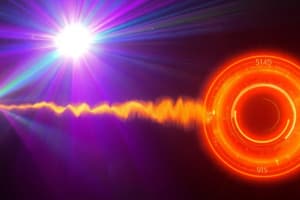Podcast
Questions and Answers
ELECTROMAGNETIC SPECTRUM It is ranging from
ELECTROMAGNETIC SPECTRUM It is ranging from
- below one hertz to above 1025 hertz, (correct)
Flashcards are hidden until you start studying
Study Notes
The Electromagnetic Spectrum: Understanding Its Components and Applications
Introduction
The electromagnetic spectrum is a continuous distribution of electromagnetic radiation. It extends from the longest waves, known as radio waves, to the shortest and most energetic waves, such as gamma rays. The human eye can only perceive a narrow band of this spectrum, commonly referred to as the visible light spectrum. However, various technologies and instruments use different portions of the electromagnetic spectrum to gather and transmit information, and scientific research often relies on studying multiple wavelengths to understand the universe better.
The Extent of the Electromagnetic Spectrum
The electromagnetic spectrum encompasses a wide range of wavelengths, from radio waves (up to 300 kilometers, or 186,000 miles) down to gamma rays (below 1 picometer). This vast range allows for diverse applications, such as wireless communications, medical imaging, and astronomy.
Technological Applications
Different regions of the electromagnetic spectrum serve distinct purposes. For instance, radio waves are used for broadcasting radio signals, while gamma rays are employed in medical imaging and detection of cosmic phenomena. By utilizing specific frequencies within the electromagnetic spectrum, engineers and researchers can develop innovative solutions and gain insights into various aspects of science.
The Visible Light Portion
The visible light section of the electromagnetic spectrum is responsible for creating all the colors humans can see. This portion of the spectrum is further broken down into seven primary colors: red, orange, yellow, green, blue, indigo, and violet, which blend together to form the white light we observe daily.
Detecting Invisible Light
Although the human eye cannot perceive ultraviolet (indigo region), infrared (red region), microwave, and radio waves directly, various tools have been developed to visualize these non-visible sections of the spectrum. For instance, the use of filters in cameras or specialized equipment enables us to capture and analyze images that reveal details otherwise hidden from our naked eyes.
The Role of the Atmosphere in Absorption and Transmission
The atmosphere plays a crucial role in regulating the amount of electromagnetic radiation that reaches Earth's surface. Certain gases, such as water vapor, carbon dioxide, and ozone, absorb or reflect specific wavelengths within the spectrum. These regions where the radiation can pass through are referred to as "atmospheric windows," allowing us to detect various phenomena with instruments placed above the atmosphere.
In conclusion, understanding the electromagnetic spectrum is vital for developing advanced technologies and expanding our knowledge of the universe. As science continues to evolve, new applications and discoveries will undoubtedly emerge, showcasing the vast potential that lies within our understanding of electromagnetic radiation.
Studying That Suits You
Use AI to generate personalized quizzes and flashcards to suit your learning preferences.




